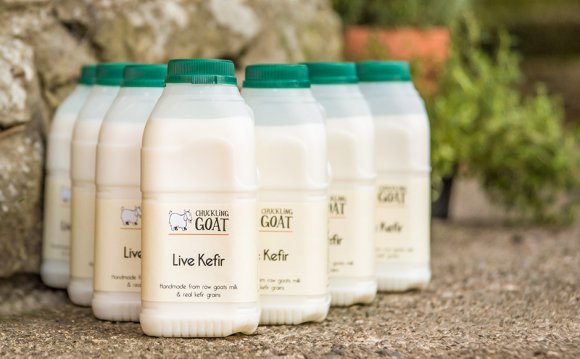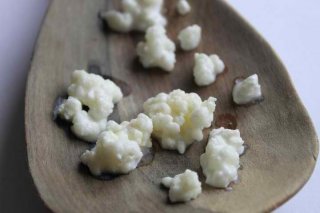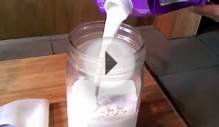
 Kefir is cultured milk, fermented with kefir grains. It is a sour, tangy yogurt-like drink that has so many health benefits. It promises so many benefits that it is almost difficult to believe. It can treat ulcer, diarrhea, acne, bronchitis, tuberculosis, leaky gut syndrome, arthritis, gout, rheumatism, depression, acne, eczema, heart problems, kidney troubles, ADHD, cholesterol problems, hepatitis, cancer and possibly HIV/AIDS, while boosting your immune system, cleansing your digestive tract and slowing down the aging process.
Kefir is cultured milk, fermented with kefir grains. It is a sour, tangy yogurt-like drink that has so many health benefits. It promises so many benefits that it is almost difficult to believe. It can treat ulcer, diarrhea, acne, bronchitis, tuberculosis, leaky gut syndrome, arthritis, gout, rheumatism, depression, acne, eczema, heart problems, kidney troubles, ADHD, cholesterol problems, hepatitis, cancer and possibly HIV/AIDS, while boosting your immune system, cleansing your digestive tract and slowing down the aging process.
To make my own kefir drink, I add milk kefir grains to milk and let the grains ferment the milk for 24-48 hours in order to produce a probiotic drink. Milk kefir culture grows as they munch on the lactose, which is why at the end of 48 hours I get a jar full of kefir drink and with more probiotic grains to re-use. I simply strain the grains, store them in a pitcher of milk in the fridge, and re-use them after I have finished my first batch of kefir drink. Here’s a step by step guide to homemade milk kefir.
Kefir grains are active cultures that look like white, miniature cauliflowers. They consist of yeast and bacteria existing in symbiotic relationship. All the healthy and magical ingredients of kefir are found in the grains; the milk is a nutritious bonus.
The milk serves as base since kefir grains thrive in milk. Any milk will do, depending on your taste and preference. Kefir grains will successfully ferment and thrive in any kind of dairy milk. The three most typical types of mammalian milk that we use to make kefir are cow, goat, sheep and camel, most possibly in that order. I like my milk raw, too. Check my post on other milk substitutes.
A lot of people don’t like raw milk and even think that it’s bad for one’s health. In fact, there are regions in the country and the world where the sales and consumption of raw milk is prohibited. However, organic food, in general, is better and much more nutritious than refined and lab-manufactured ones. This is true with raw milk as long as it was taken from healthy, clean and grass-fed cow, goat or sheep. It may not be the tastiest, though.
This is what raw milk is made of: 87.3% water, 3.9% milk fats and 8.8% of many other helpful ingredients such as lactose, whey proteins, casein proteins, calcium, phosphorous, potassium, zinc, magnesium, sodium, chlorine, iron, copper, and lactic acid, among others.
The only negative thing about raw milk is that it is not widely sold in your typical grocery. You can find them in health food stores, farmer’s markets and online.
However, while raw milk is preferred, you don’t have to push yourself to doing something that is against your will or drink something you do not like. Kefir works well with your regular grocery-bought milk. Have it your way. Prepare milk kefir using pasteurized, whole, standardized, low-fat, non-fat, UHT (ultra-heat treatment), or skimmed milk. I’m sure the probiotics won’t mind fermenting in any of these types. Whether raw or refined, milk is still considered one of the most complete foods. It has calcium, protein, fat, vitamins, and different carbohydrates, including lactose or milk sugar.
Meanwhile, kefir grains will also ferment in non-dairy or substitute milk. Try soy milk, almond milk, rice milk or coconut milk. You can still create a healthy kefir drink, although kefir grains will not grow in non-dairy liquid base. Some soy milk users, however, argue that kefir grains grow in soy milk but would take on a different form. I, personally, haven’t tried using soy milk as my milk base. To have a taste of these delicious milk kefir alternatives, make sure to first grow a new batch of kefir grains to make sure you won’t run out of living cultures.
While your grains will thrive in any type of dairy, I would suggest that you grow your kefir grains in cow or goat milk for the first 6 weeks to make sure that they are balanced and strong enough to grow in other mediums; do not expect any separation to occur with these other types of milk; they will usually just have a little fizzy taste to them.
Finally, in case you have not heard, it doesn’t have to be milk all the time. The crystal-type variant of kefir grains ferment in sugar water instead of lactose, which means you can create a water-based type of kefir. The drink is called water kefir and it is as beneficial as dairy kefir.
While milk kefir grains are white and creamy, water kefir grains are yellowish and crystalline; while milk kefir is a creamy and thick yogurt-like milk drink, water kefir is clear and bubbly like soda pop. It gets a color depending on what flavor you decide to work with. To know more about the difference of the two types of kefir, you may read my post on Water And Milk Kefir | Differences And Similarities.
To make water kefir, you first have to create a sugar-water solution. Dissolve 4-6 tablespoons of sugar in four cups of water and let it sit for sometime in room temperature. Add the grains and let the bacteria ferment the sugar for at least a day and up to 3 days. As your drink ferments, the grains create carbon dioxide, carbonating the sugar water to create the perfect alternative to soda pop. Know more on this post.
YOU MIGHT ALSO LIKE












